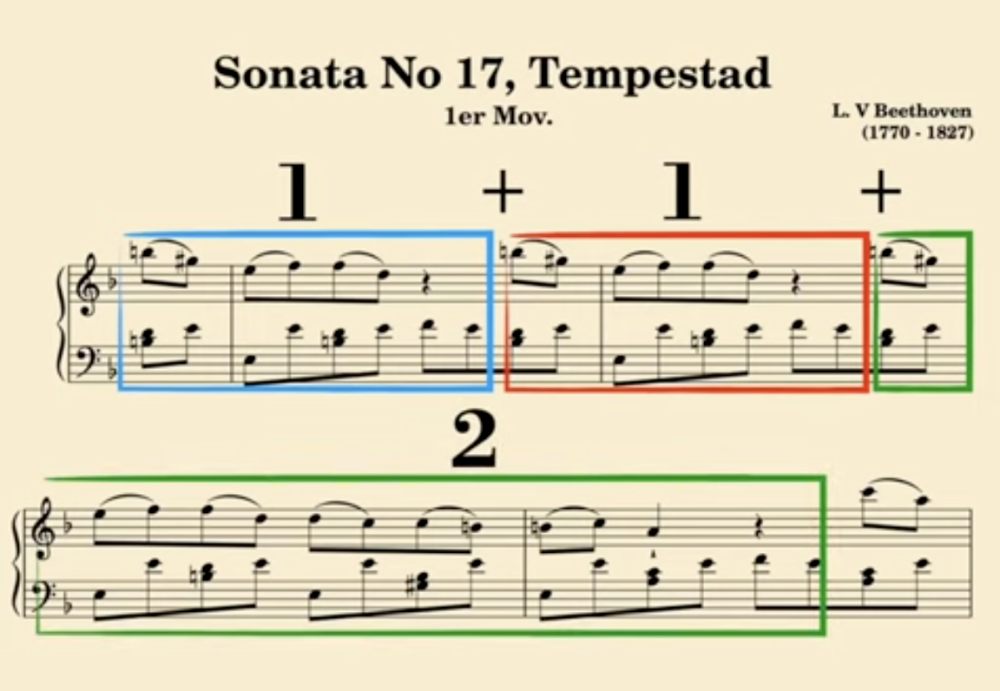All Activity
- Past hour
-
Debussy orchestration (Footsteps in the Snow)
Alex Weidmann replied to Alex Weidmann's topic in Orchestral and Large Ensemble
That's probably 'cos I'm a little odd! 🤪 Glad you liked it though. Will try con sord, though I already have flautando at the end; but I guess I could use both together? - Today
-
Henry Ng Tsz Kiu started following Piano + Synth. Pad , Preludio No.1 and Exercise in Heavily Modulatory Music
-
Hello The truth is that, although I love most pop music, when it comes to writing music, I have always done so “note by note” with orchestral instruments. But I have often heard short piano pieces where a base sound or harmonic cushion is added. Sometimes excessively so. But anyway, I wanted to try something very simple and add (in some parts) a couple of basic notes of harmony. I liked the result.
-
Hello This music sounds fantastic. Of course, I haven't looked at what modulations there are or how many, but I do think the transitions between them are very well done, which is quite important. As for modulations, which is a fascinating subject, a couple of comments: - There are dozens of ways to modulate, some simpler, others less obvious (and more subtle). I also think that depending on the style you write in, some make more sense than others. - Especially in a work of this magnitude, but in general, I think modulations should follow, or be part of, an overall plan of tension and release. Because modulating for the sake of modulating doesn't make sense either. There are some pop songs whose goal in modulating is “always” to increase tension, which modulate “downward.” However, they achieve their goal. This is a technique I want to analyze a little better. Thanks for sharing, I really enjoyed it.
-
I agree. There are many ways to generate emotion, or to try to... I don't think that a sense of calm is incompatible with resources that focus on musicality and phrasing. This is very evident in vocal music, even in the great pop performers. A very simple and effective example from Beethoven: there is a first bar, which is isolated (by the quarter note rest), there is a second bar that is identical and works the same way. And then, the two simply appear without the pause. Wow, a super-effective way to generate tension, dynamism, and phrasing without changing the basics. Charles Ives' The Unanswered Question is a fantastic example. The harmony couldn't be more static, but the melody (more or less dense in texture depending on the moment) does not conform to the divisions of the harmony. In fact, the tempo of the harmonic part is fixed (Largo) and that of the other parts changes.
-
Some Guy That writes Music started following Exercise in Heavily Modulatory Music
-
Sorry for the technical title, I don't consider this music too technical, that's why I'm keeping it's original name in the file. However for the sake of sharing, this is more of an exercise. Lately I've been upset about the lack of modulations in my music, and so I decided to go to the edge of what I can write, so I could get more comfortable writing in this harmonic style. I generally prefer diatonic music, but love key changes, and would like to improve on making strong moments when keys are changing. This piece is generally in a a very easily felt tone center but there are moments, like page 6, which the motif keep reappearing in different tonal centers, forcing the music to adjust with it. This isn't my best music, the orchestration is fine, and it's not really refined or complex, but this was an important step for me.
-
Hello!! Today I would like to share my first prelude 😄 Hope you like it.
-
Hey Peter my boy! Since you have listed out your really detailed review in point form, I should reply by point form too! 1. That is called RUBATO man!!😜 2. That's what I love in Beethoven's music too haha! I think the muddy texture is what caused the next passage to be "confused" when your mind goes muddy! 3. I love it too! That same falling fourth motive is from the beginning of the whole sonata! I think I learn this kind of German sixth progressions from Brahms. 4. I love that too, I think I am inspired by b.108 in the 1st movement when I did the same there! 5. Well not only here, but also in point 11 I only have a 1-bar transition to another passage. I would say I want these two abrupt transitions to show how confused I was at that time, but maybe they did sound too abrupt. Though I liked the effect, as if I didn't I won't retain them haha! 6. It IS difficult to play, the fingerings there are very weird to play with, but for my beloved C# minor I HAVE NO CHOICE haha. 7. Yeah that Locrian inflection here and also in the blues section comes exactly from the opening of the second movement! 8. I like that too, as I find it a bit difficult to transit reasonably with the change of style! 9. Haha yeah that melody is from the falling fourth motive of the 1st movement. This passage is hard to play with in order to emphasize that falling fourth motive in between the crazy dotted rhythms. 10. Yup the juxtaposition shows how conflicted I was then. That question like phrase is more questioning myself as I always do in my whole life lol. 11. That sweet melody comes from nowhere lol, though it's combined with the first theme of the 2nd movement at the very coda in counterpoint. That theme was born when I was having a walk. Initially I doubted whether I should introduce a new theme in the development of a final movement of a Sonata, but I just couldn't discard it given how beautiful that was, so I just retained it. 12. Yeah I don't like having the right hand playing the melody all the time haha, especially after my chamber music training. 13. Haha yeah I understand, because that passage sounds unrelated to any existing material of the whole Sonata. Though that is the passage which gave me confidence back in composing and by composing that I knew I could write good music again. It's devilish hard to play as well! 14. Yup I was more conflicted there too so I introduced the juxtaposition of material AND tempo too. Just like the ending of the 1st mov of Bee's op.130. 15. It's not from the Sextet, but rather from the second movement of this Sonata with the pentatonicism. I even quote that theme here too! 16. Yup I was conflicted whether to end the piece in a more peaceful way or tragic way, but this is my answer as I couldn't lie to myself and forced a fake Picardy 3rd ending as in many Romantic Sonatas. Thx for your review! Henry
-
Hey @Mooravioli! I never mind you taking long for replying, given that you finally do reply haha! Truly appreciate it! Thx for your repeated listenings! Yup you said all I thought in the piece. Well you are right to observe that the random pauses interrupt the flow, because that's my intention. For me the blues are just escape lands of Utopia that needed to be interrupted by the real reality particularly in the recap section when I was already more awakened than in the exposition! I realized it was futile to escape imaginarily. Haha I actually love the bluesian Fx! Thx! Yeah all the anguish and pain worths after I finish my Sextet, it's a once-in-lifetime to have completed it in this perfect (I think) way. Thank you! Henry
-

Doodle For String Orchestra
Henry Ng Tsz Kiu replied to Some Guy That writes Music's topic in Orchestral and Large Ensemble
Hi @Some Guy That writes Music! I like this very much, just like you said it doesn't sound very complex, but because of that it sounds really peaceful to listen to. Love your imitations between instruments and that Lydian Bb. Even though the opening theme recurs it doesn't sound monotomous at all given how you modulate; I love your modulation to Eb major in b.25 very much. The counterpoint there sounds really nice. And of course a very nice retransition back to C major. This music almost reminds me of some very simple yet deep film/anime music, unlike those shallow film trailer music with bombarding brass and a loud climax at the end. I hope I could have doodled something this high quality like you did haha! Thx for sharing! Henry -
Henry Ng Tsz Kiu started following A (brief?) return to music composition
-
Well, what's an invention fugue?😅 I only know Inventions OR Fugues but never know they can be combined...
-

The 12 Day War for Wind Ensemble
Henry Ng Tsz Kiu replied to Vonias's topic in Orchestral and Large Ensemble
Hello @Vonias, Welcome back! It doesn't sound atonal to me at all, I find it very much tonal given how you use tonal chords throughout the piece, though more in a Stranviskian sense and not in functional harmony. The rhythm used here reminds me of him too. For me regardless of the background of the music, I actually find it amusing and funny to listen to with the unexpected modulations and vivacious rhythm and drive. Thx for sharing! Henry -

Quick little harmony/counter-point mini-challenge :)
Henry Ng Tsz Kiu replied to UncleRed99's topic in Challenges
Hi @UncleRed99! Apart from the F# issue Luis said, I wouldn't have two F#s in the last beat of b.2 and first beat of b.3, since it doesn't sound good with two leading tones unless you have four more other tones to outbalance them in a chord for me. Thx for sharing and attracting other members to join the challenge as well haha. Henry -
Hi @MJFOBOE, It sounds nice as a march, nice endeavour. I like the middle tonic minor passage more than the main G major sections haha. Thx for sharing. Henry
-

Rhapsody for Symphony Orchestra
Henry Ng Tsz Kiu replied to A Ko's topic in Orchestral and Large Ensemble
Hello @A Ko. Welcome to the forum! This is of course an excellent first completed compostition, congrats for that! For orchestration I can't give you any tips because I'm a novice in orchestral writing myself. The beginning sounds very much like the Urlicht movement, I like it. I love that Eb major climax in b.22 very much, but in terms of the structure of the whole work I will place in much later in the piece, given how grand it is! For this intensity I think it should be put at least in the middle of the piece, or even before the ending! Love the woodwind passage in b.30. That strings chromatic figure and muted horns in f sounds VERY Mahlerian. The climax in b.43 sounds very great, but I think the time between two grand climaxes in b.30-42 as the bridge is a bit too short. I would probably extend that quiter passage with more developments on the themes before going into another climax. I love the quieter passages after the climax. I love the E major climax too! Though beware of the accidentals in b.97, those Ab should be G#. In b.144 it sounds like a Mahlerian Landler, but for me I would either develop to a longer passage or just discard it, since it sounds a bit out of place for me before the great climactic ending. I love your buildup to the ending, but I think the ending ends too quickly. Probably I would have the very nice climax stays longer, and also extend the gradual decrescendo longer for a more satisfying end. Your orchestration is really nice and probably I should learn something from it. Thx for joining and sharing your very first piece to us! Henry -
Hey @UncleRed99! Personally I feel like the time signature of the piece should be 4/4 with one quaver reduced, since I find that extra quaver beat a bit long for me, but that's personal haha. Maybe this is one of the reason the music sound more static like @Luis Hernández said. But I must say this piece is really calm to listen to and I love those dissonances of seventh. Thx for sharing! Henry
-
Hi @danishali903, thank you for all of your suggestions + for your support! I'm a string player, so I definitely have a lot to learn about writing for winds and have my editing work cut out for me (I'm going to put the 1.s and the 2.s for clarity, and will definitely make edits to the weird clef stuff haha). I also agree with you that Rhapsody may not fit very well, so I'll be thinking of more creative names in the meantime. How would you recommend adding trumpet or additional trombones? Should I try converting one of the horn parts into a trumpet part? Would you recommend adding a second trombone? Thanks! 😄
- Yesterday
-
Yes, the intent was to be more static in the creation. As recently I’ve been trying to work on my form and trying to be careful with ensuring that the melodic / harmonic voices are distinct from one another, as I have been told in previous pieces that I tend to blur the line between them at times. plus, I believe that soft/heartfelt pieces express much of their beauty within their simplicity. “Less is more” is how I see it with this sort of theme. Allowing the sound of the instruments to breathe in the air for a moment, and giving the room a chance to carry sound, in my opinion, impacts an audience better than if there was fluently complex chord structures, and limited breaks between phrases. 🙂 PS id also like to point out that this sort of theme is quite different from my typical stylistic choices when it comes to composing. So was really dipping my toes in the water with this one. I’m usually writing in a more “Adagio” or “Andante” style, rather than “Grave” or “Larghetto”
-
Nice piece! It makes me think of the C418 minecraft soundtrack. Yes, it does feel static, but personally I don't mind that at all. Although the best moments are when you break that staticness, like in bar 30-something with the sixtuplet. I like how you - when using the same chord for two successive bars - thin out / change the texture. Well done! Kind regards, Marius
-

Rhapsody for Symphony Orchestra
danishali903 replied to A Ko's topic in Orchestral and Large Ensemble
This is quite good for a first attempt at orchestral writing! I definitely hear allusions to other composers' works (Mahler, Dvorak, and Sibelius come to mind...with a hint of Bruckner). I do take issue with the title of the piece. When I think "Rhapsody", I expect something a little more virtuosic...doesn't have to be "fast", but needs more ornamentation and something show-off-y. I would call this maybe an "Orchestral Fantasy" due to its episodic form. Orchestration is a little odd for winds. You can probably reduce the flute section to just 2 + piccolo. You can also probably reduce to 4 horns. Strange there are no trumpets or additional trombones. The scoring is a bit haphazard and confusing as you can't tell which wind part is suppose to play when (unless they are constantly doubled?) Also, I've never seen a horn part using the tenor clef (and for some reason its only in Horns 5/6). -
Marc Deflin started following Victorius Loss
-
Hi @MJFOBOE I enjoyed your march. This instrumentation reminded me of the Music for the Funeral of Queen Mary by Purcell, though your work is of course in a happier - more glorious mood. This work might be see as not complicated, but it's surely efficient and pleasing. Best regards, Marc






